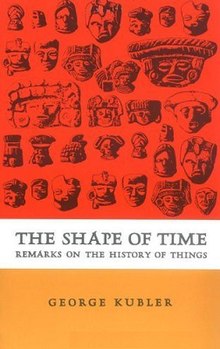The Shape of Time: Remarks on the History of Things
 First edition
| |
| Author | George Kubler |
|---|---|
| Country | United States |
| Language | English |
| Subject | Art theory, art history |
| Publisher | Yale University Press |
Publication date |
1962 |
| Media type | Print (Softcover) |
| Pages | 136 |
| ISBN | |
The Shape of Time: Remarks on the History of Things is a short book by George Kubler, published in 1962 by Yale University Press. It presents an approach to historical change which challenges the notion of style by placing the history of objects and images in a larger continuum. Kubler proposes new forms of historical sequencing where objects and images provide solutions to evolving problems. Kubler lays out a perspective where processes of innovation, replication, and mutation are in continuous conversation through time.
Kubler begins the chapter by discussing "The Limitations of Biography" where he lays out the problems encountered when thinking about objects through the histories of their makers. Within this section he discusses the importance of the point of entrance of the individual maker into the ongoing history of their objects, the role of biological and physical metaphors, and the relation between scientists and artists.
When looking back at the history of things, the historian using biological metaphors is not useful. "Purpose has no place in biology, but history has no meaning without it" (8). Kubler chose the phrase the "history of things" with the intention of rejoining objects with their ideas. The pursuit of the historian is to "identify and reconstruct" problems, actions, and solutions. "We always may be sure that every man-made thing arises from a problem as a purposeful solution" (8). In The Shape of Time, Kubler considers all man-made objects with the idea that everything is invented because of human desire and need.
While both scientists and artists are inventors, one creates solutions to solve physical problems while the other spiritual. Their histories share traits of invention, change and obsolescence (10). Although, at the same time has its extreme differences. The mechanics of a tool may be complicated but is always "intrinsically simple" (11). while a work of art may appear simple yet hold the most complex set of thoughts.
Kubler also discusses the role of the historian, the nature of actuality, and lays out his idea of self-signals and adherent signals.
Talent and Genius
The comparisons between talent and genius are explored in regard to time and degree. Leonardo da Vinci and Raphael are provided as examples; to debate between who is more talented is a moot point. Both were extremely talented artists but the other artists of the time "came late when the feast was over through no fault of their own" (7). The ideas of 'nature vs. nurture' in regard to the inheritable traits of genius; Kubler concludes that genius is indeed a result of 'nurture' as learning is not a biological concern.
...
Wikipedia
